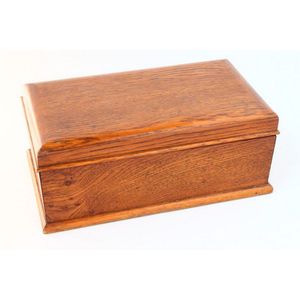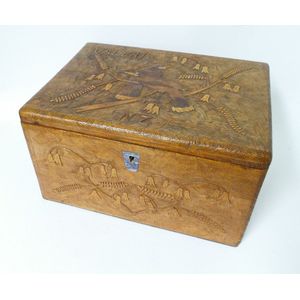Colonial Parquetry Specimen Wood Sewing Box
You must be a subscriber, and be logged in to view price and dealer details.
Subscribe Now to view actual auction price for this item
When you subscribe, you have the option of setting the currency in which to display prices to $Au, $US, $NZ or Stg.
- Circa - A Latin term meaning 'about', often used in the antique trade to give an approximate date for the piece, usually considered to be five years on either side of the circa year. Thus, circa 1900 means the piece was made about 1900, probably between 1895 and 1905. The expression is sometimes abbreviated to c.1900.
- Burr - Burr (or in the USA, burl) is the timber from the knotted roots or deformed branch of the tree, which when cut, displays the small circular knots in various gradations of colour. It is always cut into a decorative veneer, most commonly seen as burr walnut on 19th century furniture.
- Kauri - An evergreen conifer tree associated with New Zealand, but also grown in northern Australia, and islands around the Pacific rim including Borneo, Vanuatu and New Guinea. The timber is generally golden in colour, and straight grained without much knotting.
A by-product of the kauri tree was the kauri gum, the fossilised resin extracted from the tree. The gum was obtained through digging, fossicking in treetops, or more drastically, by bleeding live trees. Kauri gum was used in the manufacture of varnishes and other resin-based products, and also crafted into jewellery, keepsakes, and small decorative items.
Kauri forests were prolific in the north of the North Island of New Zealand. European settlers in the 1700 and 1800s realised that the timber from these tall trees with broad trunks would be ideal for ship building and construction and a thriving industry was established harvesting the kauri tree. The forests were substantially reduced, and now the remaining Kauri trees that grow in New Zealand are protected, and there are reserves in various areas of the North Island.
The remaining stands of kauri in New Zealand are under threat from "kauri disease", a microscopic organism that causes dieback in the trees, with vast tracts either dead or dying.
This item has been included into following indexes:
- boxes, function - sewing boxes, Australian 32
- boxes, material or decoration
- small wooden items - New Zealand 104
Visually similar items

A 17th century English leatherwork chest, with domed hinged lid, profusely decorated with varying sized brass repousse floral pattern and brass repousse flower inspired lock plate. 117 x 56 x 61 cm.

Edwardian oak document box and cover, of rectangular form, with molded lip, opening to fitted shelf, length 23 cm

A New Zealand timber folk art jewellery box, carved in low relief to the lid and walls with huia birds and kowhai, named 'Valerie' to the lid, the interior with blue velvet lining and removable tray. 30 cm x 22 cm x 17 cm

A Victorian brass bound walnut writing box, 40 cm wide, 25 cm deep, 18 cm high
